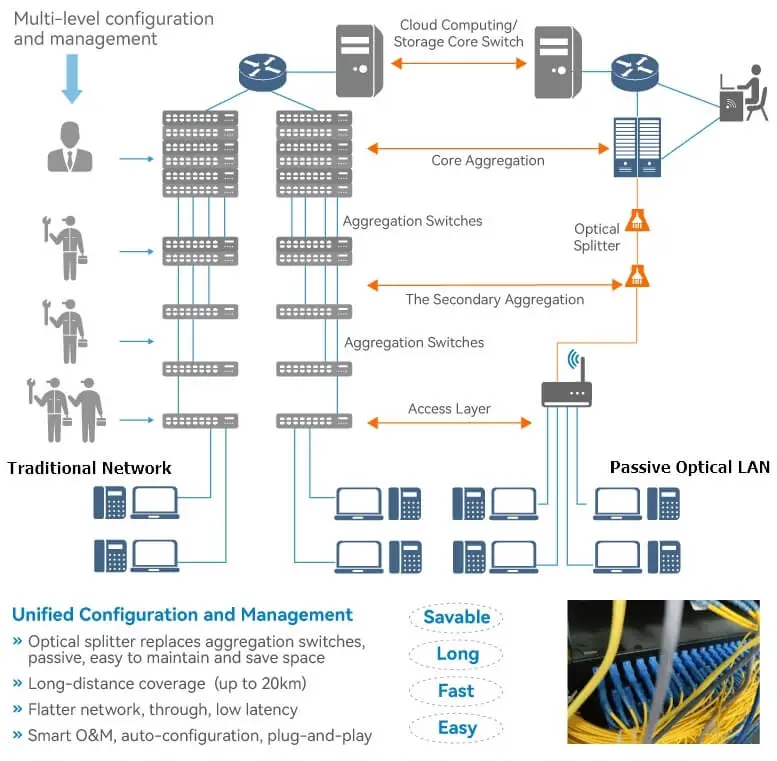In the past, the campus network always adopts traditional cabling methods. With the development of new technology like AR/VR, 4k/8k videos, WiFi 6, etc., the network traffic shoots up and some problems of the network are exposed. For instance, there is no way to manage the network uniformly because there are lots of devices and fault points. It cost a lot to set up a sole network for each of the multiple systems. In this circumstance, POL is created to solve the problems.
Part I. What is Passive Optical LAN (POL)?
POL refers to Passive Optical Local Area Network (LAN). It adopts the novel networking solution of LAN based on PON, which takes the advantage of optical fiber and P2MP, carrying all services with easy deployment and operation. Similar to all PON systems, POL is point-to-multipoint, transmitting the data from one point to multiple terminals with the optical splitter. Besides, it achieves upstream and downstream communication with WDM.
Advantages of Passive Optical LAN:
1. Long-distance network deployment
POL almost consists of single-mode optical fiber that can span 20km or longer. The distance depends on PON devices and splitter rates. It’s beneficial to the network deployment of multi-storey buildings and campus networks though not all networks need to be across a such long distance.
2. Simplify the movement, addition and modification of Network
Unlike the multi-level tree/star topology adopted by the switch, POL uses the hub-spoke structure, which makes the network flatter and more simplifier. Therefore, it’s easier to add or modify the network.
3. Improve the security
POL has problems such as electromagnet interruption and leakage. It supports AE128 encryption, ensuring the security of data transmission. What’s more, POL equipment support MAC binding, 802.1x recognition, anti-DOS attack, etc., which avoids the access and attack of illegal users.
4. Cost-saving and energy-efficient
On the one hand, the fast development of terminal devices increases the usage of bandwidth. The traditional cabling network has to reconstruct the network. However, POL is able to upgrade with bandwidth and rate of G PON,10G PON, 50G PON, etc.
On the other hand, old equipment is abandoned in the iteration of devices, which wastes cost a lot. But POL based on optical fiber networking can meet all demands of broadband. For example, the 10G PON solution or 50G PON upstream high bandwidth can carry the popular WiFi 6 services’ demand for the interface of 2.5Gbps or 10Gpbs. In general, POL is cost-saving and energy-efficient.

Part II. V-SOL Passive Optical LAN Solution to Enterprise Network
With the development of IoT and 5G, Passive Optical LAN is occupying the market. It has become the best choice for education, government, transportation, the enterprise with awesome features such as multiple services, environment, efficiency, security, etc. V-SOL provides a POL all-optical access solution to the enterprise network.
Same as PON networking, POL is composed of OLT, ODN and ONU. Here we take examples with V-SOL PON devices.
1. Shown in the frame below, the switch V3500-28G and the GPON OLT V1600G1-B are set up in the server room. The OLT downlink connects to the PLC splitter. The splitter connects to the different ONU deployed in different offices.
2. In the general office, multiple cables can be deployed to set up various networks. In this case, V-SOL ONU HG323RGW, HG3221D, and ICT3310DPS would be a great choice to be deployed here for multiple cabling network connections.
Notes:
● ONU HG323RGW: The ONU device supports dual modes including both GPON and EPON. There are 2 LAN ports. It’s compliant with IEEE802.11b/g/n.
● ONU HG3221D: There are 4 Gigabit LAN ports, 1 Gigabit WAN port, 1 12V DC power port, and a USB 3.0 port for storage and printer. It’s a dual-band ONU router with MTK WiFi 5 chipset, supporting IPV4 and IPV6. The speed can reach up to 1.2Gbps (866Mbps on the 5GHz band and 300Mbps on the 2.4GHz band).
● ICT3310DPS: ICT is a broadband access device that can provide multiple integrated services for users. The ICT can supply POE through cables for Wireless AP and VoIP.

3. In the private office, each desk was set up with each cable separately. Here we can apply V-SOL V2801SG and V2801RGW.
Notes:
● ONU V2801SG: There is only 1 E/GPON port and 1 LAN port.
● ONU V2801RGW: It’s the same as the above one but it takes WiFi antennas. It’s compliant with IEEE802.11b/g/c and its speed can reach 300Mbps. We can use it to connect telephone and PC.
4. As for the public office, similarly, we can utilize the ONU HG3221D to connect to the Internet and ICT for some office services. For example, it provides WiFi and supports supplying power to the monitoring camera.
Passive Optical LAN (POL) is applied more and more in smart buildings, commercial complexes, residential communities, industrial intelligent parks and so on. PON products are also increasingly employed in different solutions. It’s a great combination under the age of IoT and 5G!